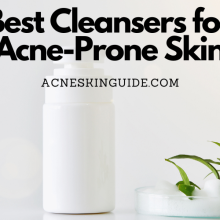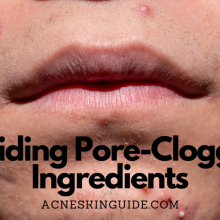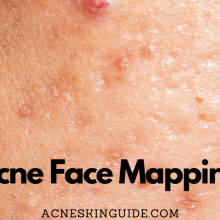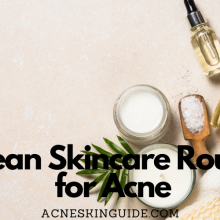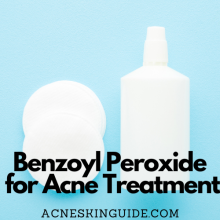Moisturizers for Acne-Prone Skin – Finding the Right One | AcneSkinGuide
Summary of Moisturizers for Acne-Prone Skin
Finding the right moisturizer is key for managing acne-prone skin. While some avoid moisturizers fearing they’ll cause breakouts, hydration is crucial for a healthy skin barrier and preventing excess oil production that clogs pores. Look for non-comedogenic, oil-free, lightweight gel or mattifying moisturizers, potentially with SPF. Beneficial ingredients include salicylic acid, hyaluronic acid, niacinamide, aloe vera, green tea, retinoids, ceramides, and antioxidants.
Choose formulas suited to your skin type – oily skin needs lightweight hydration while dry skin requires richer formulas. Morning moisturizers with SPF differ from richer nighttime versions. Both drugstore and high-end brands offer effective options. Adjust your routine if purging or irritation occurs. Moisturizers can complement other acne treatments, but don’t overdo active ingredients. A holistic approach managing stress and diet also helps control acne-prone skin.

Mastering Moisturizers for Acne-Prone Complexions: A Comprehensive Look
When it comes to managing acne-prone skin, finding the right moisturizer can be a game-changer. Many people with acne-prone skin often avoid moisturizers due to the misconception that they will cause more breakouts. However, keeping skin hydrated is crucial for maintaining a healthy skin barrier and preventing excessive oil production, which can lead to clogged pores and acne flare-ups.
Understanding Acne-Prone Skin
Acne is primarily caused by a combination of factors, including excess oil production, clogged pores, bacteria, and inflammation. Different skin types, such as oily, dry, or combination, can influence the severity and type of acne. Certain ingredients, like heavy oils, fragrances, and comedogenic (pore-clogging) ingredients, should be avoided in acne-prone skin.
Key Features to Look for in Acne-Prone Skin Moisturizers
When choosing a moisturizer for acne-prone skin, look for non-comedogenic (won’t clog pores), oil-free, and lightweight formulas. Gel-based or mattifying moisturizers are ideal for oily skin, while fragrance-free options are better for sensitive skin. Additionally, consider moisturizers with SPF for sun protection and ones suitable for different seasons/climates.
Potential downside: While non-comedogenic and oil-free moisturizers are generally recommended for acne-prone skin, some individuals may find that these formulas are not hydrating enough, leading to overcompensation and increased oil production.
Beneficial Ingredients in Acne Moisturizers
Certain ingredients can be particularly beneficial for acne-prone skin. Salicylic acid has exfoliating and anti-inflammatory properties, while hyaluronic acid and niacinamide can hydrate without clogging pores. Natural ingredients like aloe vera and green tea can soothe inflammation. Retinoids can help with acne scars and marks, ceramides support the skin barrier, and antioxidants reduce inflammation.
Potential downside: Some acne-prone individuals may experience irritation or dryness from certain ingredients, such as salicylic acid or retinoids, especially when first introducing them into their routine.
Choosing the Right Moisturizer Based on Skin Type
Oily acne-prone skin typically benefits from lightweight, oil-free, and mattifying moisturizers. Dry acne-prone skin may require more hydrating formulas, while combination skin may need a combination of products for different areas of the face.
Morning and Night Moisturizers for Acne-Prone Skin
Morning moisturizers often contain SPF and are lighter in texture, while night moisturizers can be richer and may include exfoliating ingredients like retinoids. Layering moisturizers with other acne treatments, like serums or spot treatments, can be beneficial for some individuals.
Potential downside: Using multiple products or layering treatments can increase the risk of irritation or clogged pores if the products are not compatible or if too much is applied.
Affordable vs. High-End Acne Moisturizers
Both drugstore and high-end brands offer effective acne moisturizers. When choosing between them, consider your specific skin concerns, ingredients, and formulations. Some people may need to splurge on higher-end products, while others may find affordable options that work well for their skin.
Potential downside: High-end moisturizers can be expensive, and some drugstore options may contain potentially irritating or comedogenic ingredients, making it essential to carefully read labels and ingredient lists.
Tips for Incorporating Acne Moisturizers into Your Routine
Always cleanse your face before applying moisturizer to remove excess oil, dirt, and impurities. Follow the application instructions carefully, and adjust your routine if you experience any irritation or new breakouts. Consistency is key when incorporating a new moisturizer.
Dealing with Purging and Adjustment Period
When starting a new acne treatment, including a moisturizer, you may experience a temporary increase in breakouts known as “purging.” This is normal and a sign that the product is working. However, if the purging persists or becomes severe, it may be time to switch to a different moisturizer.
Potential downside: The purging process can be frustrating and discouraging, leading some individuals to give up on a potentially effective product too soon.
Incorporating Moisturizers with Other Acne Treatments
Moisturizers can be used in conjunction with other topical acne medications, like benzoyl peroxide or retinoids, as well as oral acne treatments like antibiotics or birth control pills. For severe or persistent acne, consulting a dermatologist can help create an effective treatment plan.
Potential downside: Combining too many active ingredients or treatments can lead to irritation, dryness, and potentially disrupt the skin’s barrier function.
Lifestyle and Diet Considerations for Acne-Prone Skin
Factors like stress, hormones, and diet can influence the severity of acne. Adopting a holistic approach by managing stress, maintaining a balanced diet, and staying hydrated can complement an effective skincare routine for acne-prone skin.
Conclusion
Finding the right moisturizer for acne-prone skin involves understanding your skin type, identifying beneficial ingredients, and incorporating the moisturizer into a comprehensive skincare routine. With patience and the right approach, it is possible to keep acne-prone skin hydrated and healthy without exacerbating breakouts. However, it’s essential to be mindful of potential downsides, such as irritation, dryness, or clogged pores, and adjust your routine accordingly. If you experience persistent or severe acne, it’s always best to consult a dermatologist for personalized guidance and treatment.
FAQs and Answers
How do I know if a moisturizer is truly non-comedogenic (won’t clog pores)?
Here are some tips to determine if a moisturizer is truly non-comedogenic (won’t clog pores):
- Check the ingredient list carefully. Look for terms like “non-comedogenic,” “non-acnegenic,” or “won’t clog pores” on the label. However, don’t rely solely on these claims, as they are not regulated.
- Avoid ingredients known to be comedogenic (pore-clogging), such as certain oils (coconut oil, wheat germ oil), butters (shea butter, cocoa butter), and occlusive agents (petrolatum, mineral oil).
- Look for moisturizers that are oil-free, water-based, or formulated with non-comedogenic oils like argan oil, marula oil, or squalane.
- Opt for products with a gel-cream or serum texture, as these tend to be lighter and less likely to clog pores compared to heavy creams or ointments.
- Check for comedogenic ratings of ingredients online or in resources like the book “Break Out!” by Dr. James Fulton, which rates ingredients on a scale of 0 (won’t clog pores) to 5 (highly comedogenic).
- Patch test the moisturizer on a small area of your skin for a few days to see if it causes any new breakouts or clogged pores before using it on your entire face.
- Consider your skin type and adjust accordingly. Those with oily or acne-prone skin may need to be more cautious with richer or heavier moisturizers.
- If a moisturizer claims to be non-comedogenic but still causes breakouts for you, it may not be truly non-comedogenic for your specific skin type and chemistry.
It’s important to remember that everyone’s skin can react differently, so a bit of trial and error may be necessary to find a truly non-comedogenic moisturizer that works for your acne-prone skin.
Can I use the same moisturizer year-round, or should I switch for different seasons?
Whether you can use the same moisturizer year-round or need to switch for different seasons depends on several factors:
Climate and Weather Changes:
The weather and climate you live in can greatly influence your skin’s moisture needs throughout the year. In general:
- Summer/Warmer Months: Your skin may feel oilier and require a lighter, more water-based moisturizer to avoid clogging pores or feeling greasy.
- Winter/Colder Months: Dry air and low humidity can leave skin parched, so you may need a richer, more emollient moisturizer to prevent dryness and flakiness.
Your Skin Type:
Your basic skin type (oily, dry, or combination) also plays a role in whether you can use the same moisturizer year-round.
- Oily Skin: You may be able to use the same lightweight, oil-free moisturizer year-round, perhaps with a slightly richer formula in winter.
- Dry Skin: You’ll likely need a heavier moisturizer in winter and a lighter one in summer to adjust for seasonal changes.
- Combination Skin: You may need to use different moisturizers for dry and oily areas, adjusting the formulas seasonally.
Indoor Heating/Cooling:
Don’t forget that indoor heating in winter and air conditioning in summer can also impact your skin’s hydration needs.
Many dermatologists recommend having at least two different moisturizers – one for warmer months and one for cooler, drier months. This allows you to adjust for your skin’s changing needs and climate factors. However, if you live in a relatively stable climate or your skin remains balanced year-round, you may be able to use the same moisturizer successfully.
The key is to pay attention to how your skin looks and feels throughout the year. If it becomes excessively oily or dry during certain seasons, it’s a sign you may need to switch up your moisturizer.
Is it better to apply moisturizer on damp or dry skin?
There are arguments for applying moisturizer on both damp and dry skin, but many dermatologists recommend applying it to slightly damp skin for best results.
The case for damp skin:
- Water molecules help moisturizers absorb better into the skin. When applied to damp skin, the moisturizer can “trap” the surface moisture, enhancing hydration.
- Damp skin allows ingredients like humectants (glycerin, hyaluronic acid) to pull moisture from the environment into the skin more effectively.
- Applying on damp skin creates an occlusive layer that seals in moisture and prevents evaporation from the skin’s surface.
- For very dry skin, damp skin provides an initial hit of hydration that moisturizers can build upon.
The case for dry skin:
- Some ingredients like retinoids, vitamin C, and benzoyl peroxide can be deactivated or broken down by water. These work best on completely dry skin.
- Dry skin allows layering of products – toners/essences go on damp skin, while serums/moisturizers should go on dry skin.
- There’s less risk of over-diluting the moisturizer’s formulation if applied to dry skin.
The middle ground:
Many experts recommend a technique called “moisture sandwiching”:
- Apply a hydrating toner/mist to damp skin
- Allow skin to semi-dry before applying serum/treatment products
- Lock it all in with moisturizer on the semi-damp face
This method hydrates skin, allows treatments to work optimally on dry areas, and seals everything in with moisturizer.
The bottom line is that slightly damp skin may help moisturizer absorption for most people. But dry skin is preferable for certain actives. Listen to your skin and use the damp/dry technique that provides the best hydration without irritation.
How can I tell if my moisturizer is causing new breakouts or just purging?
Distinguishing between purging caused by a new skincare product and new breakouts can be tricky. Here are some guidelines to help determine if it’s purging or new acne:
Signs of Purging:
- Increased whiteheads, pustules or small bumps appearing in areas you normally get acne
- No new acne in areas where you don’t normally break out
- Blemishes seem to be surfacing quicker than usual acne cycles
- Purging should start within 4-6 weeks of using the new product
- No increased redness, irritation or excessive dryness around blemishes
Signs of New Breakouts:
- Appearing in new areas where you don’t normally get acne
- Taking longer than 6 weeks to start showing up
- Acne seems more widespread than your typical patterns
- Blemishes are inflamed, painful, red and irritated
- Excessive dryness, peeling or sensitivity around breakouts
- Getting pus-filled cystic acne you don’t usually experience
What Causes Purging?
Purging is a temporary reaction where a product brings already-clogged pores and bacteria to the surface quicker. Products that increase skin cell turnover like retinoids, alpha hydroxy acids, and benzoyl peroxide often initially cause purging.
General Tips:
- Be patient – true purging should clear up within 6-8 weeks
- Don’t over-dry skin – that can worsen both purging and new breakouts
- Try slowly introducing the product to allow skin to adjust
- If irritation persists over 2 months, the product may be causing breakouts
Pay close attention to types of blemishes appearing and their pattern/location. With some trial and adjustment, you should be able to tell if it’s purging that will resolve or new acne caused by the product.
Can I use the same moisturizer on my face and body if I have acne-prone skin?
It’s generally not recommended to use the same moisturizer on your face and body if you have acne-prone skin. Here’s why:
Facial Moisturizers vs. Body Moisturizers:
- Facial moisturizers are formulated specifically for the delicate facial skin, taking into account factors like acne, oiliness, and clogged pores.
- Body moisturizers are richer and thicker to hydrate the larger surface area and tougher skin on the body.
Key Differences:
- Facial moisturizers tend to be lighter, non-comedogenic (non-pore-clogging), and oil-free to avoid triggering acne.
- Body moisturizers often contain heavier oils, butters, and occlusives that can clog facial pores and exacerbate breakouts.
Acne-Prone Skin Needs:
- For acne-prone facial skin, you want a moisturizer with acne-fighting ingredients like salicylic acid or benzoyl peroxide.
- Body moisturizers don’t usually contain these acne-targeted ingredients and may worsen facial breakouts.
However, there are some exceptions:
- Some brands offer “acne body lotions/washes” with salicylic acid or benzoyl peroxide meant for body acne. These could potentially be used on the face too.
- If you have body acne as well, using separate facial and body acne products is ideal.
- If your facial acne is very mild, you may be able to use a gentle, non-comedogenic body lotion on your face carefully.
The main risk of using a body moisturizer on acne-prone facial skin is increasing clogged pores, excess oil production, and widespread breakouts. Unless it’s specifically labeled non-comedogenic, it’s best to use separate, lighter moisturizers formulated for the face when you have acne-prone skin.

